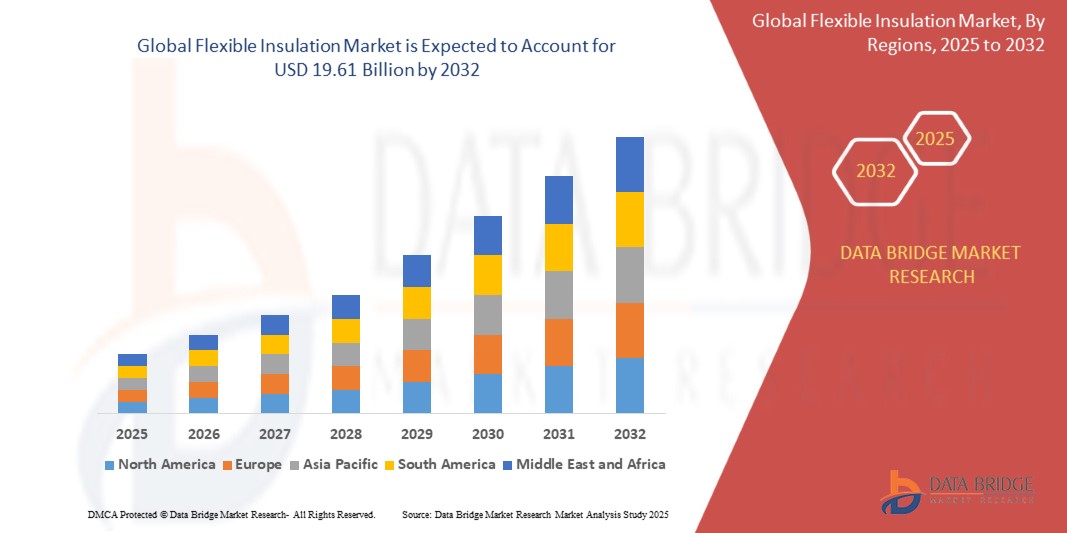Global Flexible Insulation Market
市场规模(十亿美元)
CAGR :
% 
 USD
12.61 Billion
USD
19.61 Billion
2024
2032
USD
12.61 Billion
USD
19.61 Billion
2024
2032
| 2025 –2032 | |
| USD 12.61 Billion | |
| USD 19.61 Billion | |
|
|
|
|
全球柔性絕緣市場細分,按材料(氣凝膠、交聯聚乙烯、玻璃纖維、彈性體等)、絕緣類型(隔熱、隔音和電絕緣)—產業趨勢和預測至 2032 年
柔性絕緣市場規模
- 2024 年全球柔性絕緣市場價值為126.1 億美元,預計到 2032 年將達到 196.1 億美元
- 在 2025 年至 2032 年的預測期內,市場可能以5.67% 的複合年增長率成長,主要原因是工業和住宅領域對能源效率和熱管理的日益重視
- 這一增長主要得益於政府對節能的嚴格監管、對輕質高效隔熱材料的需求不斷增長以及建築活動的增加,尤其是在發展中地區
柔性絕緣市場分析
- 柔性絕緣材料是建築、暖通空調、汽車、航空航太和工業加工等行業各種隔熱和隔音應用的重要組成部分
- 這些材料的需求很大程度上受到能源效率需求的不斷增長、排放控制監管要求以及可持續建築實踐的日益普及的推動
- 北美地區是柔性絕緣材料的主要市場之一,得益於嚴格的能源效率法規、不斷增長的改造和翻新活動以及強大的絕緣材料製造商
- 例如,美國能源部繼續推行建築能源法規和回扣計劃,鼓勵在商業和住宅領域使用高性能絕緣材料
- 在全球範圍內,柔性絕緣材料因其重量輕、易於安裝、耐用且能夠適應複雜的幾何形狀而越來越受到人們的青睞,使其成為各種應用中現代節能解決方案的關鍵要素
報告範圍和柔性絕緣市場細分
|
屬性 |
柔性絕緣關鍵市場洞察 |
|
涵蓋的領域 |
|
|
覆蓋國家 |
北美洲
歐洲
亞太
中東和非洲
南美洲
|
|
主要市場參與者 |
|
|
市場機會 |
|
|
加值資料資訊集 |
除了對市場價值、成長率、細分、地理覆蓋範圍和主要參與者等市場情景的洞察之外,Data Bridge Market Research 策劃的市場報告還包括進出口分析、生產能力概覽、生產消費分析、價格趨勢分析、氣候變遷情景、供應鏈分析、價值鏈分析、原材料/消耗品概覽、供應商選擇標準、PESTLE 分析、波特分析和監管框架。 |
柔性絕緣市場趨勢
“日益關注可持續和節能解決方案”
- 全球柔性絕緣市場的一個突出趨勢是建築、汽車和工業領域越來越重視環保節能的絕緣材料
- 隨著企業和政府致力於實現淨零碳排放目標並提高建築能源性能,由再生材料、天然纖維和低排放聚合物製成的柔性絕緣產品越來越受歡迎
- 例如,氣凝膠毯和生物基泡沫等先進的柔性絕緣解決方案因其優異的耐熱性、低厚度和環境效益而被綠色建築項目採用
- 在汽車領域,輕量化和電動車的趨勢正在加速柔性絕緣材料的使用,以減少熱負荷並提高電池效率
- 對永續性的關注不僅減少了碳足跡,還為提供創新、高性能和環保絕緣產品的製造商開闢了新的成長途徑
柔性絕緣市場動態
司機
“各行業對能源效率的需求不斷增長”
- 工業、商業和住宅領域對節能和熱效率的日益重視,大大促進了對柔性絕緣材料的需求增加
- 石油天然氣、暖通空調、建築、汽車和航空航天等行業需要高性能隔熱材料,以最大限度地減少熱量損失、降低能耗並保持溫度穩定性
- 隨著全球越來越重視減少碳排放和遵守嚴格的能源法規,柔性絕緣解決方案因其多功能性、易於安裝以及在狹窄或不規則空間中的有效性而迅速被採用
- 工業環境中的需求尤其高,鍋爐、管道和儲槽等設備需要可靠的隔熱才能有效率且安全地運行
例如,
- 根據國際能源總署 (IEA) 的數據,到 2023 年 9 月,工業能源消耗將佔全球最終能源消耗的 37% 以上,這將推動對隔熱改造和熱優化技術的投資增加
- 2022 年 3 月,歐洲絕緣材料製造商協會 (EURIMA) 的報告強調,增強工業設施的絕緣性能可節省高達 25% 的能源,凸顯了柔性絕緣材料在提高營運效率方面的重要性
- 因此,對節能和永續基礎設施和設備的需求不斷增長,繼續成為全球柔性絕緣市場強勁的成長動力
機會
“擴大綠建築倡議和永續建築”
- 全球日益重視永續建築和綠色建築認證,例如 LEED 和 BREEAM,為柔性絕緣市場帶來了重大機會
- 柔性絕緣材料,包括彈性泡沫、玻璃纖維和聚乙烯,有助於提高能源效率、減少排放和改善室內空氣質量,所有這些都是永續建築標準的關鍵標準
- 隨著政府和私人利益相關者繼續投資環保基礎設施,柔性隔熱材料在新建和改造項目中都變得至關重要,特別是對於改善牆體、暖通空調系統、屋頂和管道的熱性能
例如,
- 2024 年 10 月,世界綠色建築委員會宣布,預計到 2030 年,G20 國家 40% 的建築將採用可持續隔熱和節能係統進行改造,這將使柔性隔熱材料處於有利的增長地位
- 2023 年 12 月,美國能源部 (DOE) 推出了新的建築能源法規,要求住宅和商業建築採用更高的隔熱標準,鼓勵採用高性能柔性隔熱產品
- 永續建築實踐的激增為柔性隔熱材料製造商提供了一個長期機會,使他們能夠透過專為綠色認證建築設計的環保、可回收和高性能隔熱解決方案來擴展其產品組合
克制/挑戰
“高昂的材料和安裝成本限制了其廣泛應用”
- 柔性絕緣材料的高成本及其特殊的安裝要求可能會成為其廣泛採用的重大障礙,尤其是在價格敏感或發展中市場
- 氣凝膠、高性能彈性泡棉和多層層壓板等優質柔性隔熱產品的價格可能比傳統的硬質隔熱替代品貴得多
- 除了材料成本外,通常還需要專業的安裝服務來確保最佳的熱性能和規範合規性,這會增加整體專案費用
例如,
- 2023 年 9 月,建築市場研究集團的報告顯示,商業建築中柔性隔熱材料安裝的平均成本比剛性隔熱材料高出 20-30%,這主要是由於其需要大量勞動力和熟練的技術人員
- 2024 年 4 月,國際能源總署 (IEA) 指出,成本仍然是中小型建築公司和房主採用先進隔熱材料的阻礙因素,限制了其在中低收入地區的市場滲透
- 因此,這些高昂的前期成本可能會阻礙潛在用戶投資柔性隔熱材料,從而減緩市場成長,儘管柔性隔熱材料具有長期節能效益
柔性絕緣市場範圍
市場根據材料和絕緣類型進行細分。
|
分割 |
細分 |
|
按應用 |
|
|
依產品類型 |
|
柔性絕緣市場區域分析
“北美是柔性絕緣市場的主導地區”
- 受嚴格的能源效率法規、先進的工業基礎設施以及暖通空調系統和石油天然氣應用的高需求推動,北美在柔性絕緣市場佔據主導地位
- 美國佔據了相當大的份額,這得益於其廣泛採用節能建築實踐、對永續建築技術的投資不斷增加以及各行各業對減少碳排放的高度重視
- 政府大力鼓勵節能,大型絕緣材料製造商的存在進一步鞏固了該地區的市場領導地位
- 此外,石化設施、資料中心和冷鏈物流對隔熱材料的需求不斷增長,以及住宅和商業建築的改造活動不斷增加,正在推動北美市場的擴張。
“亞太地區預計將實現最高成長率”
- 受快速工業化、城市發展以及新興經濟體日益重視能源效率的推動,亞太地區預計將出現柔性絕緣市場的最高成長率
- 由於建築活動不斷擴大、暖通空調安裝量成長以及製造業產量不斷上升,中國、印度和韓國等國家正成為主要市場
- 由於政府大力推行綠建築標準與節能法規,中國對柔性絕緣產品的需求尤其強勁
- 印度快速的城市擴張和基礎設施建設,加上發電和石油天然氣產業的投資,進一步加速了市場的成長
- 全球絕緣材料製造商的不斷增長,加上人們對永續能源使用意識的不斷提高,預計將在預測期內推動該地區的柔性絕緣材料市場發展
柔性絕緣市場份額
市場競爭格局按競爭對手提供詳細資料。詳細資訊包括公司概況、公司財務狀況、收入、市場潛力、研發投入、新市場計劃、全球影響力、生產基地和設施、生產能力、公司優勢和劣勢、產品發布、產品寬度和廣度以及應用主導地位。以上提供的數據點僅與公司在市場中的重點相關。
市場中主要的市場領導者有:
- 陶氏(美國)
- 巴斯夫公司(德國)
- 科思創股份公司(德國)
- 聖戈班(法國)
- 歐文斯科寧(美國)
- Kingspan集團(愛爾蘭)
- 約翰斯·曼維爾(美國)
- 可耐福保溫材料公司(德國)
- 阿樂斯(德國)
- Aspen Aerogels, Inc(美國)
- 卡博特公司(美國)
- 亨斯邁國際有限公司(美國)
- Lapolla Industries, Inc.(美國)
- SAFCO泡沫絕緣材料(美國)
- 卡真泡棉隔熱材料。 (美國)
- 聖戈班集團(法國)
- EnergyGuard 泡棉絕緣體,LP(美國)
- 大陸集團(德國)
全球柔性絕緣市場的最新發展
- 2024年9月,阿樂斯在印度開設了一家新的氣凝膠隔熱材料生產工廠。該工廠旨在提升該公司下一代氣凝膠產品的生產能力,滿足建築和工業領域對高性能隔熱材料解決方案日益增長的需求。
- 2023年11月,Kingspan集團推出了首款生物基柔性保溫產品Hemkor。 Hemkor旨在利用再生資源提供高性能保溫,順應產業轉向永續建築材料的轉變。
- 2023年,Etex收購了丹麥絕緣專家Skamol。這項策略性舉措旨在增強Etex在高溫絕緣解決方案領域的產品組合,並擴大其在柔性絕緣市場的影響力。
- 截至2024年3月,全球柔性隔熱材料市場規模約100億美元,預計2034年將達到172億美元,複合年增長率(CAGR)為5.6%。這一增長主要源於建築業對能源效率和永續性的日益重視。
SKU-
Get online access to the report on the World's First Market Intelligence Cloud
- Interactive Data Analysis Dashboard
- Company Analysis Dashboard for high growth potential opportunities
- Research Analyst Access for customization & queries
- Competitor Analysis with Interactive dashboard
- Latest News, Updates & Trend analysis
- Harness the Power of Benchmark Analysis for Comprehensive Competitor Tracking
研究方法
数据收集和基准年分析是使用具有大样本量的数据收集模块完成的。该阶段包括通过各种来源和策略获取市场信息或相关数据。它包括提前检查和规划从过去获得的所有数据。它同样包括检查不同信息源中出现的信息不一致。使用市场统计和连贯模型分析和估计市场数据。此外,市场份额分析和关键趋势分析是市场报告中的主要成功因素。要了解更多信息,请请求分析师致电或下拉您的询问。
DBMR 研究团队使用的关键研究方法是数据三角测量,其中包括数据挖掘、数据变量对市场影响的分析和主要(行业专家)验证。数据模型包括供应商定位网格、市场时间线分析、市场概览和指南、公司定位网格、专利分析、定价分析、公司市场份额分析、测量标准、全球与区域和供应商份额分析。要了解有关研究方法的更多信息,请向我们的行业专家咨询。
可定制
Data Bridge Market Research 是高级形成性研究领域的领导者。我们为向现有和新客户提供符合其目标的数据和分析而感到自豪。报告可定制,包括目标品牌的价格趋势分析、了解其他国家的市场(索取国家列表)、临床试验结果数据、文献综述、翻新市场和产品基础分析。目标竞争对手的市场分析可以从基于技术的分析到市场组合策略进行分析。我们可以按照您所需的格式和数据样式添加您需要的任意数量的竞争对手数据。我们的分析师团队还可以为您提供原始 Excel 文件数据透视表(事实手册)中的数据,或者可以帮助您根据报告中的数据集创建演示文稿。















